Archive for May, 2009
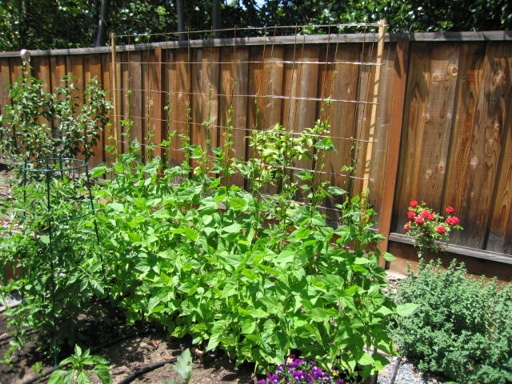
I planted a new crop of green pole beans back in March around the first day of spring. I planted seeds that I harvested from dried bean pods on the Italian beans growing in our garden last year. I also planted some blue lake pole bean seeds that I bought from a local store.
The seeds sprouted in about 2 weeks and have grown incredibly fast since then, especially in the past few weeks. They have already grown several inches up the support from where they were just a few days ago!
In the past few years since I started growing beans again, I have been growing each group of beans up a single pole. The problem with this technique is that when the beans get large and heavy they tend to slide down the pole. For years, my mom used chicken wire held up by 2 poles on each side to support her annual crop of pole beans. But when the beans get large and heavy by late July, the chicken wire support begins to sag down in the middle.
This year, I decided to use a different technique. I nailed two 6′ tall wooden posts to the edge of one of our raised beds. Then, I screwed small hooks into the posts near the tops of the posts. I then hung a wire frame on the hooks. The wire frame is made up of rigid metal wire that is about 2 mm thick. I think it’s the type of wire frame that’s used in supporting concrete.
The wire is flexible enough to bend, but only with sufficient force. I can bend it with my hands, but it probably won’t bend under the weight of the beans. It’s not flimsy like chicken wire, but it has wider openings between the wires.
I bought a 4′ x 8′ piece of this wire frame from a local hardware store for about $8. I mounted the bottom of the wire frame about 12 inches off the ground. Beans don’t usually need support until they are about a foot tall. So far, our new bean support system seems to be working well.
May 09 2009 | Beans | Comments Off on Green Beans Growing Fast
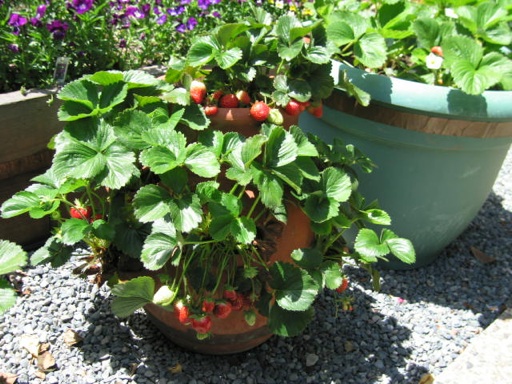
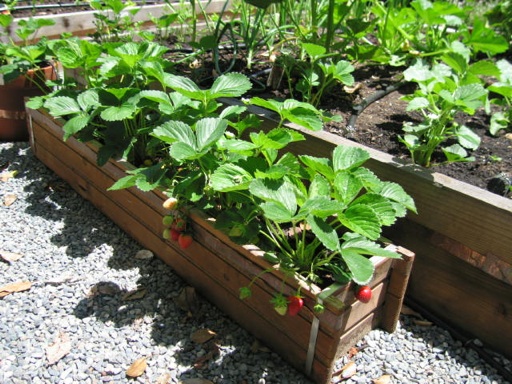
The long days and warm weather have arrived, and our plants are loving it. Our long day Sequoia strawberries started ripening about two weeks ago. Today, I picked a whole bowl full of strawberries, which we enjoyed for lunch.
Strawberries are probably one of my favorite garden plants. Our Sequoia strawberries have grown really well in our garden and have produced many strawberries. Our home grown strawberries are so delicious. They are softer and sweeter than the strawberries I typically buy in grocery stores.
In order to get more plants, I let the runners from last year’s strawberries root in our raised beds, and then I transplanted them into pots back in December. The second photograph above shows the same strawberries pictured in my December 29th post. I now have about 15 strawberry pots, because I had so many runners last year. The newly planted strawberries from last year’s runners are growing very fast and are getting lots of berries. But even the strawberry plants that are 2-3 years old are growing and producing many high quality berries. The first photograph above shows strawberries that are about 2 years old.
Some of the newly planted strawberries from last year’s runners are already starting to generate runners of their own. This year, I plan to trim some of the runners so that I don’t get as many. I have read that cutting off the runners encourages the plants to produce more strawberries, although I haven’t tried this technique yet. I have noticed that the older strawberries do not seem to generate as many runners.
Recently, I decided to try experimenting with some new day neutral strawberries. I planted several Quinault strawberries about 3 years ago, and I was really unhappy with them. They produced very few strawberries. The strawberries they did produce were small and tough, even though they were growing under the same conditions as the Sequoias, which have always been wonderful. A few weeks ago, I planted Seascape and Aromas. Both are day neutral strawberries that are supposed to produce strawberries over a longer season. I admit I will be surprised if they taste as good as Sequoia.
I have read that strawberries will not produce berries when the daytime high temperatures exceed 85 degrees F on a regular basis. We are lucky here, because the summertime highs average around 77-80 degrees, and daytime highs above 85 degrees are rare except for the occasional heat wave. Last year, we harvested strawberries from May through August, except for about a month in June. I attribute that gap to not fertilizing them regularly. As soon as I started to fertilize them, they began to produce berries again.
May 09 2009 | Strawberries | Comments Off on Strawberry Season Is Here
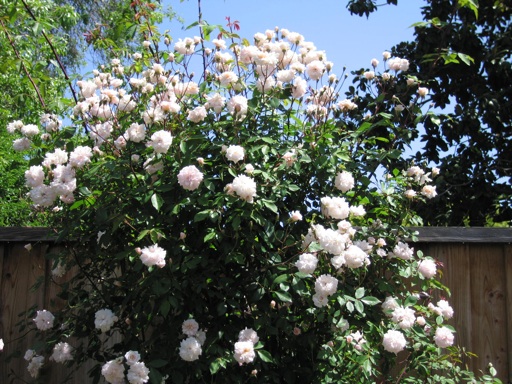
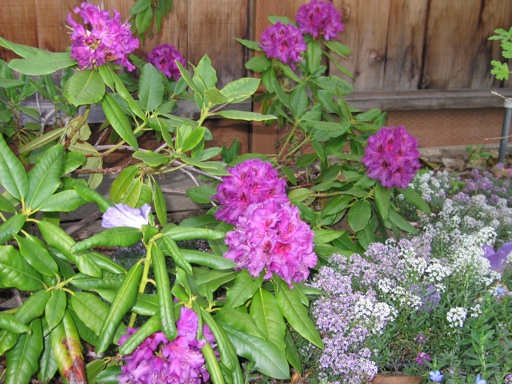

These are more pictures of flowers that are blooming in our garden this spring. The first picture is of a Cecil Brunner climbing rose. Each spring, they are filled with hundreds of cute miniature flowers for a few weeks. But they only bloom once a year. The rest of the year they grow profusely. A bit too profusely in my opinion. I stopped watering them two years ago to try to stunt their growth. But it didn’t work. They still grow dozens of new thorny vines every few months during the growing season. Pruning the new growth has only slowed them down a little. I planted them next to the fence, so they might be getting water from the neighbor’s yard. I am probably going to cut them back severely in a few weeks.
The second picture is a purple rhododendron. I have had this bush about 6 years, and it has bloomed reliably every year. I really love of the color of its flowers.
Rhododendrons like shade in warm climates, acidic soil, and lots of water. Ours is planted in partial shade, although our soil is not particularly acidic. I give it azalea/rhododendron fertilizer once a year in the spring and that has be enough to get it to flower.
The last picture is group of lavender bearded irises. These irises were here when I moved into the house. I almost never water or fertilize them, and they have produced very few blooms. This year they have more flowers than they have ever had. In our climate, we get very little rain from May through October. Bearded irises are supposed to be drought tolerant. I am not sure if they don’t bloom much because they are not getting enough water or fertilizer or both.
May 03 2009 | Flowers and Irises and Rhododendron and Roses | Comments Off on More spring flowers
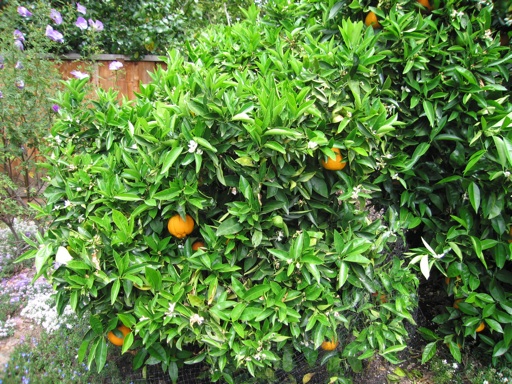
We are lucky enough to live in a house that has an established navel orange bush (see picture). It was planted by one of the previous owners. This bush must be over 20 years old given the girth of its trunk.
Our navel orange bush produces the best tasting oranges I have ever eaten. The flesh of the oranges is soft and tender, unlike the tough fleshed oranges I typically buy in the supermarket. And the flavor is superb. They are juicy, with a nice sweet-tart orange flavor. Although I cannot be sure what type of navel it is, I believe it is a Washington navel given the high quality of the fruit. Washington (Bahia) navel is generally considered to be the best tasting orange.
Although navel oranges are known for ripening in the winter, our navel oranges are ripe now, in April and May. Our climate is probably too cool to stimulate winter ripening, but it appears to be warm enough to generate some very good fruit. Our summer highs average in the high 70s to low 80s, and our winter highs average in the 50s.
The first two years I lived in this house, the leaves of this bush would turn yellow each spring. Then, I learned that yellowing leaves is typically a sign of a lack of nitrogen. Oranges need lots of nitrogen, particularly in the spring when they are growing and blooming. For the past several years, I have been fertilizing our two oranges (navel and valencia) once a month from February through July with a general purpose fertilizer, 16-16-16. The first of these three numbers indicates the percentage of nitrogen in the fertilizer.
I give each bush 3-4 cups in each application, because both of them are quite mature at this point. The result has been more blooms, more oranges, and beautiful dark green leaves throughout the spring and summer months.
Some of our neighbors have large orange trees. They never seem to fertilize them and yet they always look beautiful! I am not sure how they get away with neglecting these trees. Although, our bushes often have more oranges even though they are smaller. 😉
May 03 2009 | Oranges | Comments Off on Navel Orange Bush
« Prev






